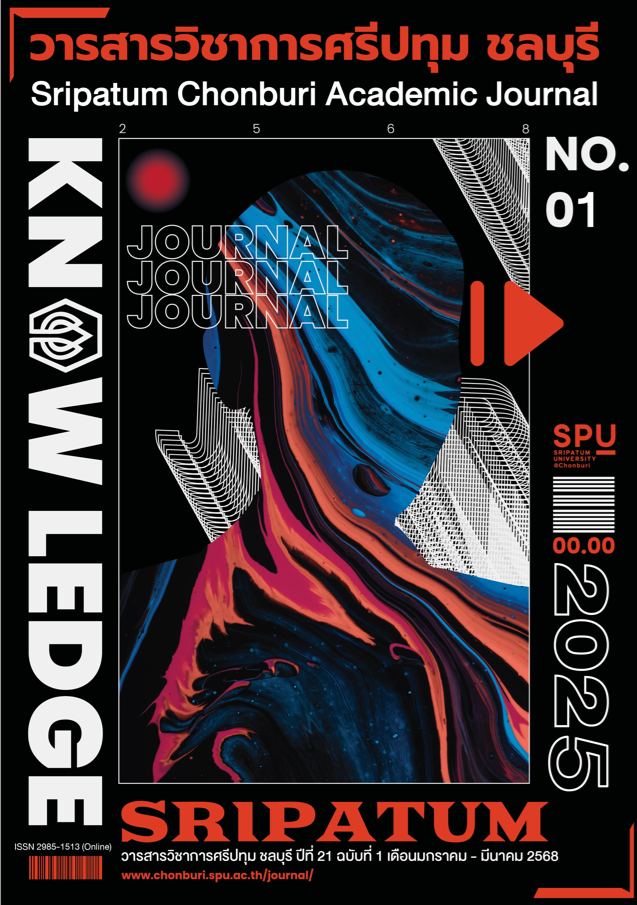A DEVELOPMENT OF AR TECHNOLOGY-INTEGRATED LEARNING MATERIALS ON THE HUMAN BODY’S ORGAN SYSTEMS FOR GRADE 8 STUDENTS
Keywords:
AR Technology, Body Organ System, Media IncorporatingAbstract
This research aimed to: 1) develop AR-integrated learning materials on the human body's organ systems for Grade 8 students, 2) assess the quality of the AR-integrated learning materials, 3) compare students' learning outcomes before and after using the AR-integrated learning materials, and 4) determine students' satisfaction with the AR-integrated learning materials. The sample group, selected through purposive sampling, consisted of 36 Grade 8 students from the Science-Mathematics program at Satri Nakhonsawan School. Data analysis methods included independent samples T-test, standard deviation, means and percentage.
The research findings indicated that the learning materials included images, videos, and an application incorporating AR technology. The overall quality of the learning materials, as evaluated by content experts, was rated as good (Mean=4.45, SD=0.37). Similarly, the overall quality of the learning materials, as evaluated by multimedia experts, was also rated as good (Mean=4.47, SD=0.55). The effectiveness of the learning materials was measured at 89.05/81.78, exceeding the established criterion of 80/80. A comparison of pre-test and post-test scores revealed that the pre-test scores (Mean=12.14) were 48.56%, while the post-test scores (Mean=21.19) were 81.78%. The calculated t-value was higher than the table t-value, indicating a statistically significant improvement in students' learning outcomes at the .05 level. The overall satisfaction with the learning materials was rated as very high (Mean=4.55, SD=0.67).
References
กระทรวงศึกษาธิการ. (2560). ตัวชี้วัดและสาระการเรียนรู้แกนกลางกลุ่มสาระการเรียนรู้วิทยาศาสตร์ (ฉบับปรับปรุง พ.ศ.2560) ตามหลักสูตรแกนกลางการศึกษาขั้นพื้นฐาน พุทธศักราช 2551 (ออนไลน์). เข้าถึงได้จาก: https://www.ipst.ac.th/wp-content/uploads/2021/04/IndicatorSci2560.pdf [2565, 14 กันยายน].
ดวงมณี แสนมั่น, นนกาญจน์ ฉิมพลี และวิภาวรรณ อารยะชัย. (2561). การพัฒนาสื่อการเรียนการสอนด้วยแอปพลิเคชันบนสมาร์ตโฟนในรายวิชาโลหิตวิทยา. วารสารมหาวิทยาลัย-ศิลปากร, 38(3), หน้า 73-89.
ธนพงษ์ ไชยลาโภ, เอกลักษณ์ โภคทรัพย์ไพบูลย์ และปริญญ์ โสภา. (2559). การพัฒนาสื่อบทเรียนออนไลน์เรื่อง: การออกแบบเพื่อการผลิตสื่อปฏิสัมพันธ์ และมัลติมีเดีย. วารสารวิชาการนวัตกรรมสื่อสารสังคม, 4(2), หน้า 134-143.
บุญชม ศรีสะอาด. (2560). การวิจัยเบื้องต้น (พิมพ์ครั้งที่ 10). กรุงเทพฯ: สุวีริยาสาส์น.
พัชรี ปุ่มสันเทียะ. (2563). การพัฒนาสื่อการเรียนการสอนด้วยเทคโนโลยีความเป็นจริงเสริมในรายวิชาภาษาจีนสำหรับนักเรียนชั้นมัธยมศึกษาปีที่ 4. วิทยานิพนธ์การศึกษามหาบัณฑิต สาขาวิชาเทคโนโลยีและคอมพิวเตอร์เพื่อการศึกษา, คณะครุศาสตร์ มหาวิทยาลัยราชภัฎพิบูลสงคราม.
มหาวิทยาลัยราชภัฏนครราชสีมา. (2561). ความสำคัญของวิทยาศาสตร์มีอะไรบ้าง (ออนไลน์). เข้าถึงได้จาก: www.stem.nrru.ac.th/article/2/ความสำคัญของวิทยาศาสตร์มีอะไรบ้าง [2565, 14 กันยายน].
โรงเรียนสตรีนครสวรรค์. (2565). ด้านที่ 3 ข้อมูลนักเรียน (ออนไลน์). เข้าถึงได้จาก: http://www. sns.ac.th/Information_School/03-Educational-Information-School.pdf [2565, 14 กันยายน].
รัตติยากร วาปีกัง, ศศิพร พงศ์เพลินพิศ และ สุชีรา มะหิเมือง. (2563). การพัฒนาความสามารถด้านการเรียนรู้คําศัพท์ภาษาอังกฤษโดยใช้การจัดการเรียนรู้ด้วยเทคโนโลยีความเป็นจริงเสริมของนักเรียนชั้นมัธยมศึกษาปีที่ 1 โรงเรียนฤทธิณรงค์รอน. วารสารเทคโนโลยีและสื่อสารการศึกษา, 15(8), หน้า 12-22.
วราพร บุญมี. (2564). สื่อการสอนกับการเรียนรู้ในศตวรรษที่ 21. วารสารการบริหารนิติบุคคลและนวัตกรรมท้องถิ่น, 7(9), หน้า 373-385.
สุนทรี มนตรีศรี. (2562). การพัฒนาเทคโนโลยีเสมือนจริงเรื่องสร้างงานแอนิเมชั่นสำหรับนักเรียนชั้นมัธยมศึกษาปีที่ 5. วิทยานิพนธ์ครุศาสตรอุตสาหกรรมมหาบัณฑิต สาขาวิชาเทคโนโลยีทางการศึกษา, คณะครุศาสตร์อุตสาหกรรมและเทคโนโลยี สถาบันเทคโนโลยีพระจอมเกล้าเจ้าคุณทหารลาดกระบัง.
เอชอาร์ โนท. (2564). การศึกษา (Education) สำคัญอย่างไรกับการพัฒนาทรัพยากรมนุษย์ (ออนไลน์). เข้าถึงได้จาก: https://th.hrnote.asia/ orgdevelopment/190625-education-for-hrd/#:~:text=การศึกษาทำให้มนุษย์มี,หรือปรับปรุงแก้ไขปัญหาให้ [2565, 14 กันยายน].
อัครเทพ อัคคีเดช. (2563). การพัฒนาสื่อเทคโนโลยีความเป็นจริงเสริมเรื่องเครื่องดนตรีสากลสำหรับนักเรียนชั้นประถมศึกษาปีที่ 4 โรงเรียนสาธิตมหาวิทยาลัยศรีนครินทร์วิโรฒ องครักษ์. วิทยานิพนธ์การศึกษามหาบัณฑิต สาขาวิชาศิลปศึกษา, คณะศิลปกรรมศาสตร์ มหาวิทยาลัยศรีนคริทรวิโรฒ.
Teeranathanakul, Pairot, & Kiatiknmol, Paiboon. (1998). Creating IMMCAI Package. Journal of Industrial Education, 1(5), pp. 14-18.
Downloads
Published
Issue
Section
License
Copyright (c) 2024 Sripatum University Chonburi Campus

This work is licensed under a Creative Commons Attribution-NonCommercial-NoDerivatives 4.0 International License.
บทความทุกบทความเป็นลิขสิทธิ์ของวารสารวิชาการศรีปทุม ชลบุรี



